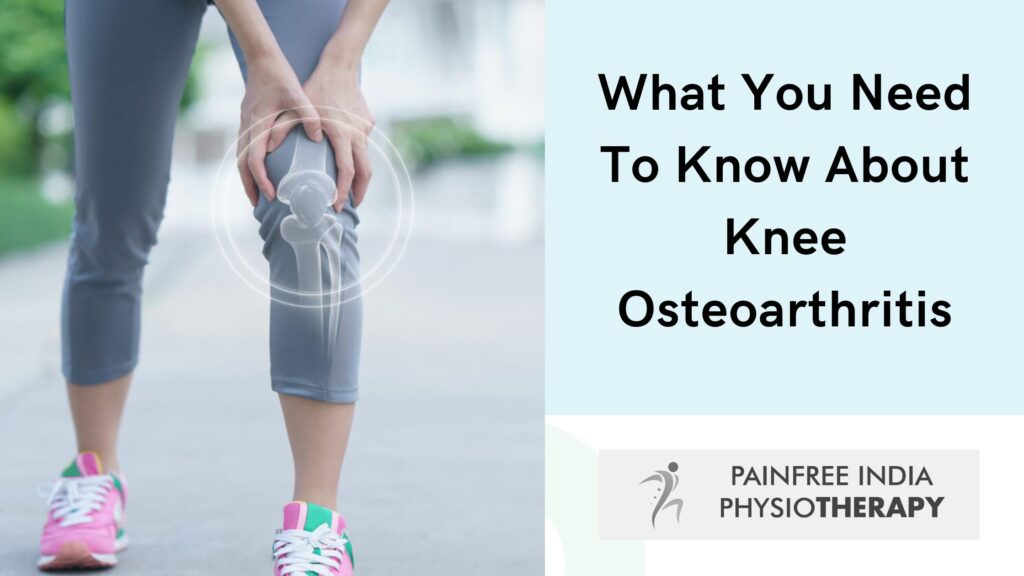
You could be one of the millions of people worldwide who have knee osteoarthritis if you’ve been experiencing knee pain, stiffness, or swelling. The cartilage in your knee joint begins to wear away over time, causing knee osteoarthritis, a degenerative joint disease that causes pain and discomfort. We’ll discuss knee osteoarthritis in this article, what you need to know about it, and how knee physiotherapy can help you manage your symptoms.
Understanding Knee Osteoarthritis
When the cartilage in your knee joint begins to deteriorate, a condition known as knee osteoarthritis results. Your joints’ cartilage, a tough, rubbery tissue, cushions them and aids in smooth movement. The bones in your knee joint rub against one another as it ages, causing pain, stiffness, and swelling. Age, trauma, or obesity can all contribute to the development of knee osteoarthritis.
Symptoms of Knee Osteoarthritis
The symptoms of knee osteoarthritis can vary from person to person, but typically include:
- Pain in your knee joint, especially if you move or put weight on the injured leg.
- Stiffness and difficulty moving your knee joint.
- Swelling and tenderness around your knee joint.
- A crunching or grinding sensation when you move your knee.
- Diagnosis and Treatment of Knee Osteoarthritis
It’s crucial to see a doctor who can diagnose knee osteoarthritis and suggest the best course of treatment if you’re exhibiting any of its symptoms. To get a better look inside your knee joint, your doctor may prescribe an X-ray or MRI.
Osteoarthritis of the knee is typically treated with a mix of physiotherapy, medication, and lifestyle modifications. Losing weight, exercising frequently, and adopting supportive footwear are a few examples of lifestyle adjustments. Pain and inflammation may be lessened with the aid of medications like painkillers or anti-inflammatory drugs. Knee physiotherapy can also be very successful in treating knee osteoarthritis symptoms.
Knee Physiotherapy for Knee Osteoarthritis
Physical therapy that focuses on strengthening, stretching, and improving the function of your knee joint is known as knee physiotherapy. You can have a customised treatment plan created for you by an Orthopedic physiotherapist in Delhi or a best physiotherapist in Gurgaon, which could include:
Exercises that increase range of motion for your knee joint.
Exercises that increase muscle strength around the knee joint can support the joint and lessen pain.
Low-impact exercises that can keep you active without putting too much strain on your knee joint include swimming and cycling.
Techniques used in manual therapy, such as massage or manipulation, can help reduce pain and increase mobility.
You can protect your knee joint from further harm by getting knee physiotherapy. To keep your knee joint strong and flexible, your physiotherapist might recommend some stretches and exercises for you to do at home. They may also recommend lifestyle changes such as losing weight or avoiding activities that put too much stress on your knee joint.
To come up with the best treatment strategy for your particular needs, it’s crucial to consult frequently with your doctor and physiotherapist. Knee osteoarthritis symptoms can be controlled with the right strategy while still leading an active, healthy lifestyle.
Conclusion :
Knee osteoarthritis is a common condition that can make the knee joint hurt, stiffen, and swell. It’s crucial to get medical help and consider your treatment options if you’re exhibiting these symptoms. Knee physiotherapy has the potential to be a very effective method for treating knee osteoarthritis symptoms and enhancing quality of life. Working with an orthopedic physiotherapist in Delhi or a best physiotherapist in Gurgaon can assist you in creating a tailored treatment plan that addresses your particular needs and enables you to resume your favourite activities. For the best joint health and to prevent further damage, keep up a healthy lifestyle, exercise frequently, and take care of your knees.

Leave feedback about this